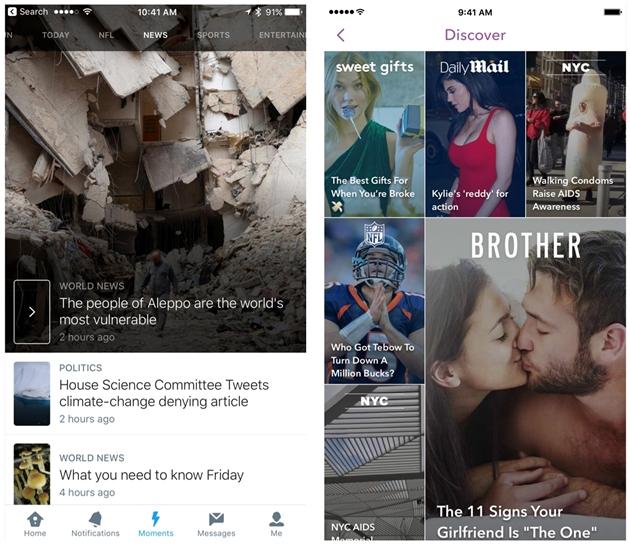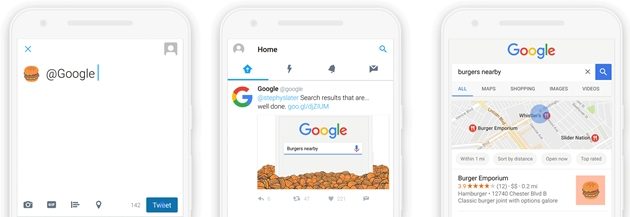This week's dose of social: Facebook takes on both fake news and Snapchat's success; Google makes itself searchable with emojis—on Twitter; regulators give a final nod to Microsoft's acquisition of LinkedIn; Twitter Moments arrives for brands and users on mobile; the marketing conferences you shouldn't miss in 2017; social giants band together to take terror content offline; and much more...
Skim for what you need to know!
1. Facebook continues its siege with a new Snapchat Discover competitor
Facebook Collections is the new publisher program from the social network, and it's set to tackle Snapchat's Discover and Twitter's Moments features by showcasing lists of content curated by publishers directly within users' News Feeds.
Between the social titan's introduction of Stories to Instagram, emulating Snapchat's popular Story feature, the Collections rumors suggest an aggressive push by Facebook to make up for its failed acquisition of the ephemeral messaging app years ago.
No rollout schedule for Collections has been made public, but Facebook has held talks with media outlets and entertainment companies in recent weeks about creating content for it.

2. You can now search Google by tweeting with emojis
Have you ever wanted to search Google, but just couldn't figure out a way to put your query into words? Well, now you can use emojis to help out. That's right, Twitter users will now receive search results from the search engine simply by tweeting an emoji to the Google Twitter account.
Tweet an umbrella emoji to receive the chance of rain in your area, or the burger emoji to receive a listing of burger joints nearby. The only catch? Location services need to be enabled for the service to work.
The system currently understands and responds to around 200 emojis, so users can begin exploring and get quicker search results with this new shorthand form of Google searching. We've officially become lazy (or illiterate).
3. Final regulators clear the path for Microsoft-LinkedIn deal
The European Commission—the final regulatory body needed to sign off on the acquisition of LinkedIn by Microsoft—was given the green light this week.
To appease the European regulators, Microsoft and LinkedIn had to provide some concessions, such as commitments to making sure that LinkedIn competitors don't become completely disadvantaged on Microsoft platforms. In June, Microsoft announced its intentions to acquire LinkedIn.
4. Twitter Moments now available for mobile users
After initially launching the feature with only a few publishing and media partners, Twitter opened up Moments—its curated content feature—to all users globally back in September on the Web. Now, the company wants users to be able to create a narrative with a collection of linked tweets on mobile.
That means there's now an even easier way to create a Moment about your company's latest event or product launch, crafting a more professional narrative about your brand on the social network.
To get started, all you do is hit the down arrow in the top right of any published tweet and select "Add to Moment" to launch your collection of posts. Moments also allow companies—and users—to search for material from other Twitter users to help flesh out their collection, and get some user-generated content in the mix. Happy posting!
With Moments, you can bring together favorite Tweets to tell richer stories - rolling out on mobile starting today.twitter.com/i/moments/8036…
5. Social media ad spending set to overtake newspaper ad spend
Despite political and economic concerns, advertising agency Zenith Optimedia predicts, global advertising spending on social media will continue to grow to account for 20% of all Internet advertising in 2019 and should take over newspaper ad spending by 2020.
Marketers continue to shift spending to social media networks, where the near native-advertising format easily blends into newsfeeds as opposed to lower performing, more interruptive display advertising. The report forecasts ad spending growth to reach 4.4% in 2017, the same rate as in 2016.
6. Facebook taking on fake news with survey to users
It appears part of the social network's solution to combating fake news on the platform lies partially in asking users what they think constitutes fake news. The new Facebook survey appears at the bottom of certain posts and requests that users rank to what extent the identified story uses misleading language.
Facebook has confirmed the survey, but it hasn't given any indication as to how it's being used to identify clickbait or fake news, nor how the data is retained or used. Users can bypass or simply scroll past the call-to-action survey, if desired, but perhaps answering one or two would be beneficial to all of us.
7. How to find social media micro-influencers for your small business
Need to promote your business, but don't have the funds to secure top-dollar influencers with millions of followers on social channels? Highly targeted micro-influencers could be the answer to your brand's gaining visibility, engaging with its audience, and promoting its products and services for less. The Social Media Examiner offers help.
Covered in detail: Finding micro influencers among your followers, researching hashtags to find influential users, locating relevant local bloggers, and using third-party tools to find people in your brand's niche.
Want more on the topic? Here you go:
8. Facebook testing new feature to find—and meet up with—nearby friends
The social network is expanding its Nearby Friends feature and testing a new "Send Wave" capability that lets users send nearby friends a waving hand emoji to say hello and make it easier to organize meetups.
A Facebook spokesperson has confirmed the test, and suggested it's a way to help users interact with each other in fun and lightweight ways.

9. Five ways to connect with your customers on Periscope
Looking to foray into live video, but not quite sure what approach would be best for your brand? The live video format is set to explode in 2017, so you probably don't want to be left in the dust. Luckily, here are five great ways to dip your toes in and get your customers engaged.
Receive a lot of email inquiries regarding the functionality of a specific product? Organize a livestream event that showcases its use first-hand, and let consumers engage and ask questions. Want suggestions for an event you plan to host next month? Check in with those that might attend via a live stream to see what their expectations are. There are dozens of ways to make Periscope work for you.
10. The state of social media in 2016
A recent survey from the Pew Research Center gives us an inkling of where social platforms stood in 2016, and marks a moment of reflection for brands to review where they focused their social media marketing strategy throughout the year.
Facebook was still by-and-far No. 1, with 68% of American adults claiming to be users, while Instagram took the second slot with 28%. Some 51% of Instagram users reported visiting the platform daily, and 42% of Twitter users claim the same level of usage.
Find out how the rest of the platforms stack up, and use the insights to reflect on where your brand might need to go in 2017.

11. 2017 marketing conferences you shouldn't miss
Cost, value, and timing are three key things to look at before you decide which marketing conferences you'll set your sights on in 2017. Luckily for you, the folks at TrackMaven have already dug in and identified the 12 gatherings guaranteed to serve you best—and social media is certainly bound to play a big role at each.
12. Social, Internet giants join forces to remove online terror content
Facebook, Microsoft, YouTube, and Twitter announced plans on Monday to cooperate on steps to minimize the spread of terror content online via the use of digital "fingerprints."
The companies will work on a shared industry database to identify content by assigning them each a unique identifier, subsequently determine whether items flagged by their algorithms and matched with those within the database should be removed.
Although Facebook notes that personal information will not be shared, it didn't say it wouldn't be collected. The government can still use the law to find out on which accounts the questionable content originated, and the social networks will continue deciding how they handle those requests and which requests are disclosed to the public.




